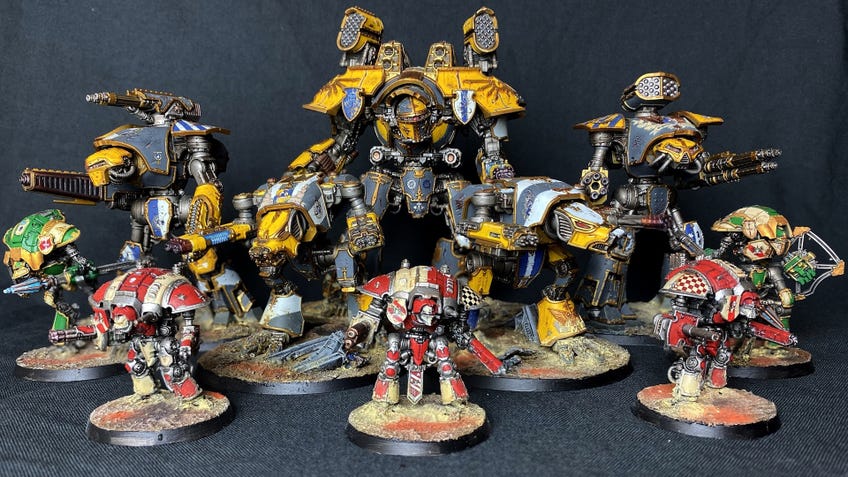Adeptus Titanicus: the staggering Warhammer 40,000 game where stories loom as large as mechs
"We wanted each death to be memorable."
Next to a bombed-out habitation block, a mighty Reaver titan utters a bestial roar as its servos generator begins to overload, the smaller, stilt-legged form of a Cerastus Knight sinking its lance into the exposed engine. As the god-machine stumbles blindly forward, it smashes its 100-tonne chainfist into the head of the Reaver opposite it, cleaving through its armoured exterior and obliterating the head where the titan’s operating crew - otherwise known as a Princeps - resides.
From her position in a Warlord titan several clicks away, the Senior Princeps sighs, watching two of the god-engines stumble into each other, weapons firing randomly, catching Knights and Warhounds alike, one of the reactors glowing white-hot through cracks in the baroque armoured plating.
I roll a ten on a die, and consult a damage table. Critical reactor meltdown. Grinning from ear to ear, I measure the radius around the Reaver, cackling at all the units about to be caught in the wake of a mighty explosion - the gamble paid off.
Games Workshop’s Adeptus Titanicus is exceptional. Set during the Horus Heresy - a period of time 10,000 years before the current setting of Warhammer 40,000, when the various arms of the Imperium are embroiled in a bitter civil war due to the influence of chaos - it is a game of staggering scale, inexorable momentum and devastating weaponry, all of which blend together to create stunning cinematic moments on the tabletop. Its rules are short, yet involved; dense, yet elegant; and granular enough to tell excellent stories but not so overloaded that it becomes a dry simulation. After you have a few battles under your belt, you’ll be able to play with just a single double-sided piece of A4 for reference, with much of the important information being stored on the command terminals of your mech-like titans.
As far as I am concerned it is Games Workshop’s best game. It takes plastic miniatures and turns them into towering god-machines: ancient constructs that tower over the battlefield, lumbering forward with all the grace and poise of battleships, unloading salvos of cacophonous weapons into each other.
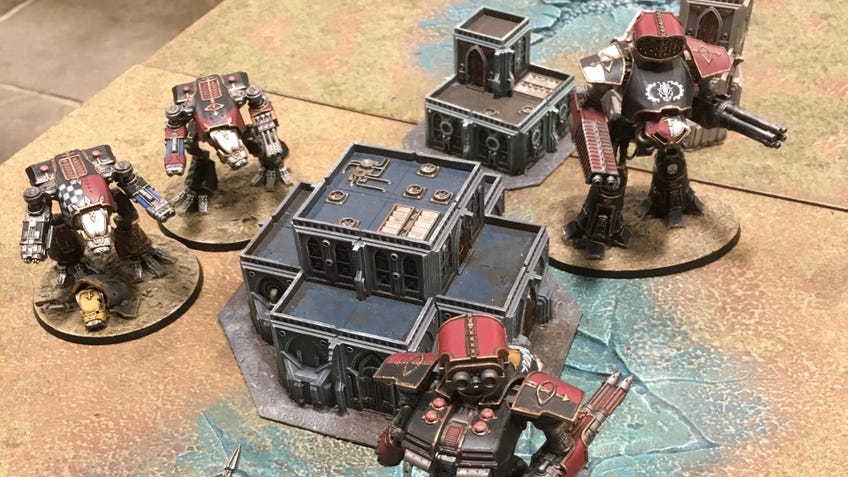
Current-day Adeptus Titanicus is a slick, modern reimagining of one of Games Workshop’s oldest games, 1988’s identically-named Adeptus Titanicus. In the early days of the design for 2018’s reboot James M. Hewitt, lead game designer for the modern adaptation, began his research by getting a hands-on look at an original playtest copy of Adeptus Titanicus owned by Tony Cottrell, the head of GW’s specialist game and model arm Forge World. (Hewitt left Games Workshop in 2017 to co-found independent studio Needy Cat Games.)
In true ‘80s fashion, Hewitt says it was “a real relic - a box of musty cardboard and polaroid photographs, and a rulebook printed with a dot matrix printer on continuous stationery”. Combined with Space Marine and Epic 40,000 - small-scale wargames that allowed players to field huge armies of war machines - Cottrell's prototype formed a core part of the research Hewitt did, which also extended to other things such as tabletop game Heavy Gear, video games MechWarrior and Titanfall, and films like Pacific Rim.
“We still do this when we design games at Needy Cat; we read around the game’s theme and try to find out what the common themes and tropes are, so we can bake them into the game’s core mechanics," Hewitt says.

Ultimately, not much of the original game survived in the 2018 reboot, with Hewitt and his colleagues deciding to drop most of the things they had tested. (Hewitt is keen to highlight the “massive team effort” behind the game, with the designer, sculptor Chris Drew and manager Andy Hoare joined by various members of Games Workshop’s Forge World studio to hash out concepts and playtest the game.) This likely goes a fair way to explaining some of the elegance inherent in the newer system - ask anyone who played second-edition Warhammer 40,000 and they’ll tell you it was a far more obtuse and granular affair compared to today’s Warhammer 40,000: Eighth Edition, for better or worse.
Instead of granularity, the team dug into the slight disconnect between giving and executing a command. Hewitt explains that they “did everything we could to put the player in the role of a Princeps commanding a crew who are controlling a titan” and the issues that naturally follow when you issue a command to a 33-metre-tall engine of destruction.
“There’s a small degree of slippage between what you want to happen and what actually happens,” Hewitt says. “It’s a slightly imperfect system!”
This is keenly felt in Titanicus’ sense of movement. Unlike simpler games, facing and movement are not something you take for granted as bigger titans turn slowly and infrequently, with facing crucial due to weapon and armour arcs.
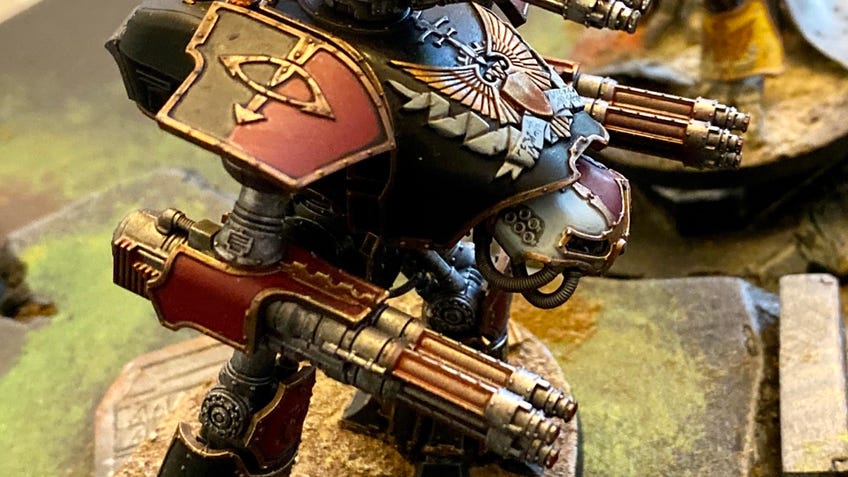
The three main units in Titanicus are, in order of descending scale, the Warlord, the Reaver and the Warhound. As you'd expect, the smaller the titan, the greater the degree of manoeuvrability, which Hewitt explains gave the team “an interesting lever to pull when differentiating the classes of titan”, allowing for Warhounds to easily flank and dance around lumbering Warlords.
Regardless of agility or armour, titans can be destroyed, another aspect Hewitt and his colleagues focused on to communicate scale. Given the handful of models on the table, the designer says that “we wanted each death to be memorable, because all of the titan fiction that GW has ever produced has conveyed an engine kill to be a huge moment”.
The last thing we wanted was for a player to spend a significant chunk of money on a kit, then watch it die in a single volley of fire.
Depending on the heat levels of their engines and the damage they have already succumbed to, a titan can do anything from stand still to catastrophically implode. Eagle-eyed fans will recognise many of the results have been lifted directly from the fiction.
“Wild Fire - where the dying titan falls and spray its weapons randomly - came from one particular panel in Dan Abnett’s awesome Titan graphic novel, where an ork Mega Gargant tears one of its allies to shreds as it collapses to the ground,” Hewitt points out.
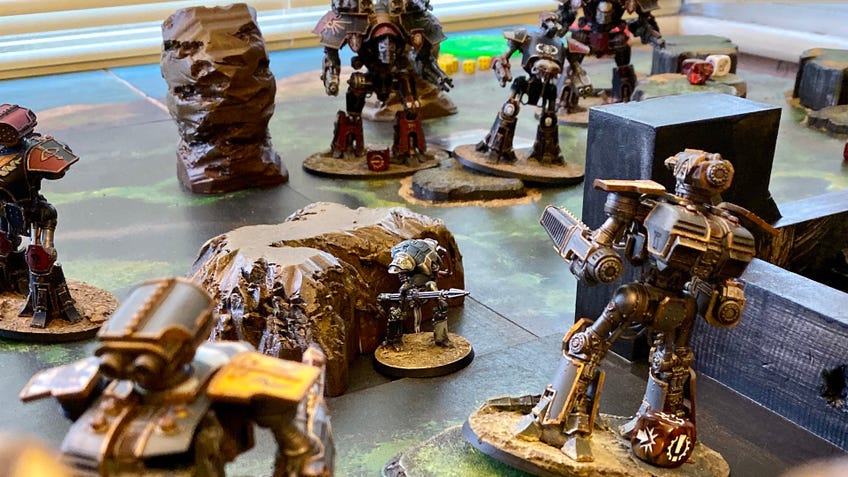
Even though things die in spectacular fashion in Titanicus, it can take a long time to get them there. Each towering mech is represented in game by a wonderfully detailed model on the battlefield, but also a cardboard terminal that displays its systems at a glance. There are status tracks for void shield status, reactor heat and the damage able to be taken by the head, body, legs and weapon. Rather than binary wounds, damage is incremental and adds up.
Hewitt explains that the balance testing the team did when designing the game was invaluable to keeping titans feeling terrifying, but the weapons feeling suitably destructive; during development, the team were under the impression that the game would be a specialist game with more expensive resin kits for models, leading to a situation where Hewitt thought players would be disappointed if single-turn kills were a possibility.
“The last thing we wanted was for a player to spend a significant chunk of money on a kit, spend a serious amount of time building and painting it… then watch it die in a single volley of fire,” he said. “Even though they ended up being plastic kits, the ethos lived on, and I’m really glad it did.”
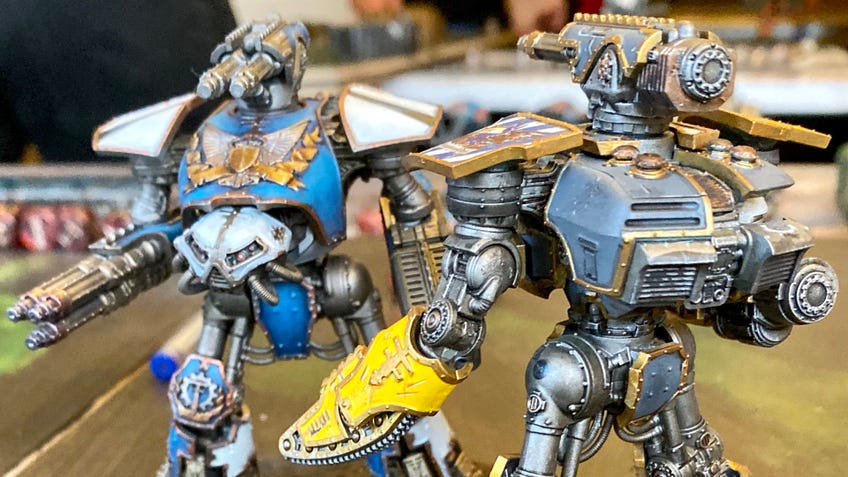
When asked what his favourite aspect of Titanicus is, Hewitt says that it always changes, but that currently it's the incremental damage system. It lends a wonderful sense of credence to the size and workings of these huge machines, wonderfully summed up by the designer’s gleeful explanation.
“First, your void shields degrade - but it’s okay, you can get them back, and you’re still fighting at full strength,” Hewitt says. “A titan can weather several bursts of fire while feeling functionally invincible, which is a great feeling for the target player. Eventually, the void shields fail. That’s where you start to worry - getting them back up is never a sure thing, and now you’re going to start taking structural damage. Even the smallest titan has a fair bit of armour which can soak up some damage, but it’s a finite resource. Once you’ve taken enough structural damage, all incoming attacks start to get a damage bonus – so damage gathers inexorable momentum, like a boulder rolling downhill.”
A titan can weather several bursts of fire while feeling functionally invincible, which is a great feeling for the player.
The idea of momentum is present throughout Adeptus Titanicus, figuring into both movement and damage, but also the way you dish out orders and commands. Unlike core Games Workshop titles like Warhammer 40,000, Titanicus has alternating activations - you take turns in the same phase dishing out orders, rather than doing all of your movement in one go. This sees you thinking a few moments ahead, desperately trying to work out just how far you can push your titans, where your opponent will be and what status you’ll both be in when weapons start to fire.
Predicting your opponent’s actions and trying to out-think them rather than outgun them creates a suitably cinematic feel, and matches tend to play out with a clear narrative. The dramatic difference in scale between titan classes means you need to lean into their specialisations in a way that's rewarded.
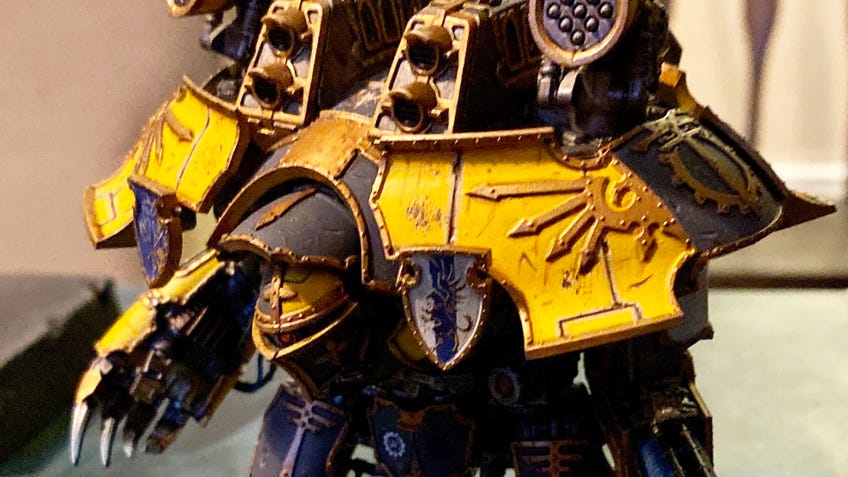
Hewitt mentions the connection between the fiction of titans and the mechanics themselves. “The existing GW titan fiction was utterly vital to the development of the game,” he comments. “I started reading back through it all, highlighting and bookmarking sections. First, I was doing this from the point of view of ‘the game needs to replicate this sort of thing’, but this gradually evolved into ‘Oh, wow, this is exactly something that would happen in the game - awesome!’”
Recalling the Black Library books that helped Hewitt and the team shape the game, he brings up the point in the testing and development where the systems really clicked.
“There’s a scene in one of them - I think it’s Mechanicum, but it might be Titanicus - where there’s a moment that I really wanted to recreate in the game.
“A Princeps of a Warlord titan realises that they’re actually in danger. They’re used to being the biggest and scariest thing on the field, but they’re in an environment that absolutely suits the smaller, more agile engines and they suddenly feel vulnerable. We tested this scenario about halfway through development, pitching a Warlord against a pair of Warhounds on a small table that was full of dense urban terrain… and it worked.”
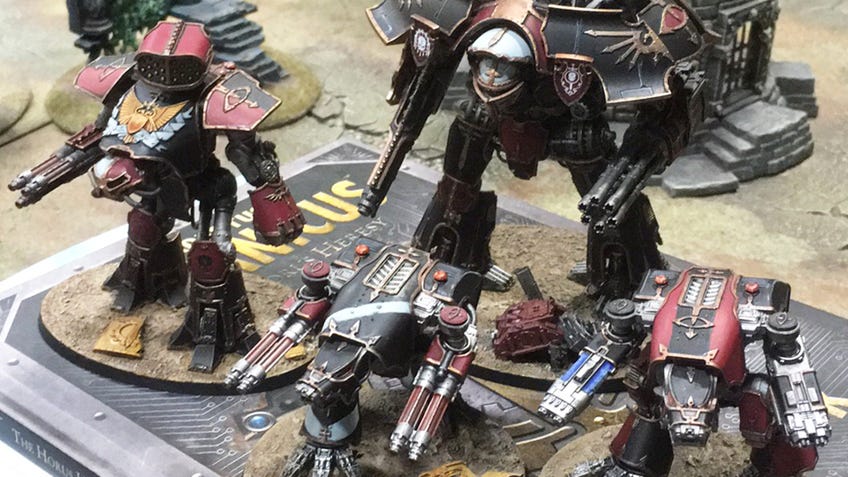
Hewitt says the team were in a position where the game had been “pulled apart and reworked maybe half a dozen times”, but this was the moment in time where it all finally clicked. It’s something I've seen in my own battles - the low, skulking form of a Warhound finds it far easier to avoid the tight firing arcs of a Warlord, especially with a good terrain setup, creating tense and explosive cat-and-mouse games.
Everything fits together in such a way that it’s easy to remember standout moments from games in the same way you can pick out passages in similar fiction. Lone titans weathering voluminous fire before Knights flank and cripple their opponents, or unintentionally hilarious domino scenarios as titans combust and stumble into each other, drunkenly firing their guns at friend and foe alike. None of this needs to be extrapolated from the vagaries of the rules, as the systems Hewitt and his colleagues worked on are robust enough to convey all of this, and more, with just a handful of dice.
It works wonderfully, and this is down to the elegance of the design. Hewitt says that it was keeping the focus on just the titans themselves that resulted in the game being so evocative.
“The game design process was really focused on making sure we got titans right - we wouldn’t have been able to be quite so focused if we were also including infantry, armoured columns [and] flyers.”
The game design process was really focused on making sure we got titans right.
By avoiding weighing the system down with rules that tried to approximate interactions between mechs that can crush a tank column underfoot without a hitch, Titanicus became a game where the back and forth of gigantic god-engines feels palpable and exciting. With the recent launch of the aerial combat game Aeronautica Imperialis, Games Workshop has left itself the option of tying in similarly small-scale games to create a larger air, sea and land-style wargame in the future. Should that not come about, Titanicus will continue to be tight, elegant and mechanically punchy. It is a game of consequential scale and hefty momentum, delivering cinematic moments frequently, well deserving of the praise it has received, all thanks to the team’s commitment to scale and narrative play.
Now that his own time as steward of the game is over, Hewitt is able to see the future of Titanicus unfold, and continue to witness the dynamic stories that his systems brought to life.
“I left them enough interesting hooks to develop the game as far as they want to! I’m now in the fascinating position of watching the game grow from the outside”
